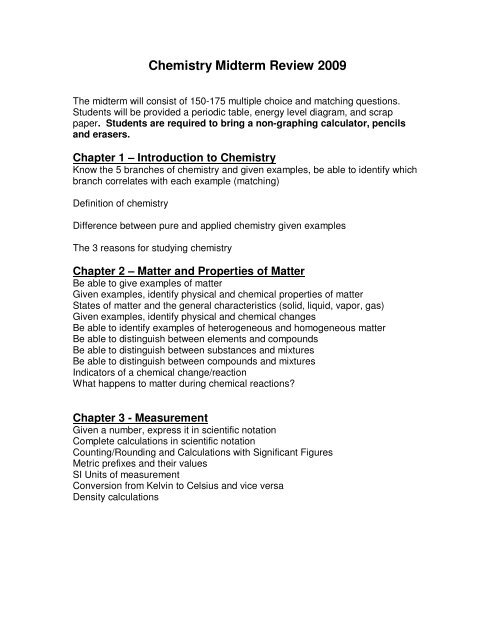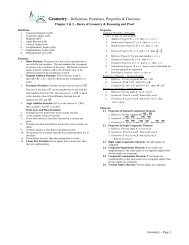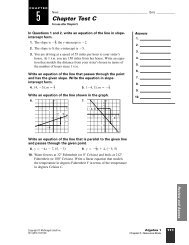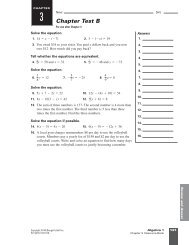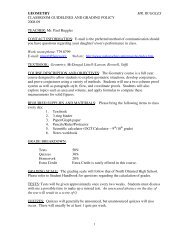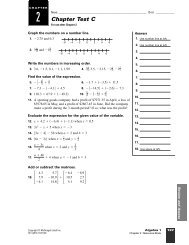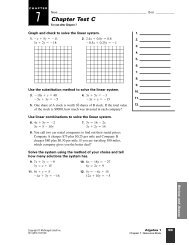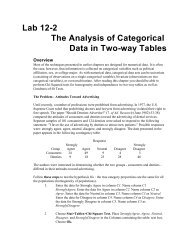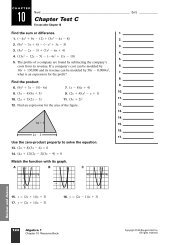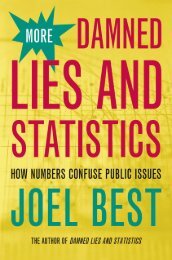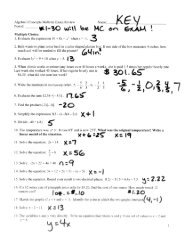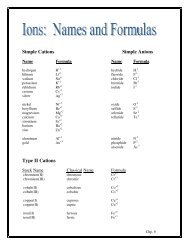Chemistry Midterm Review 2009 - NOHS Teachers
Chemistry Midterm Review 2009 - NOHS Teachers
Chemistry Midterm Review 2009 - NOHS Teachers
You also want an ePaper? Increase the reach of your titles
YUMPU automatically turns print PDFs into web optimized ePapers that Google loves.
<strong>Chemistry</strong> <strong>Midterm</strong> <strong>Review</strong> <strong>2009</strong><br />
The midterm will consist of 150-175 multiple choice and matching questions.<br />
Students will be provided a periodic table, energy level diagram, and scrap<br />
paper. Students are required to bring a non-graphing calculator, pencils<br />
and erasers.<br />
Chapter 1 – Introduction to <strong>Chemistry</strong><br />
Know the 5 branches of chemistry and given examples, be able to identify which<br />
branch correlates with each example (matching)<br />
Definition of chemistry<br />
Difference between pure and applied chemistry given examples<br />
The 3 reasons for studying chemistry<br />
Chapter 2 – Matter and Properties of Matter<br />
Be able to give examples of matter<br />
Given examples, identify physical and chemical properties of matter<br />
States of matter and the general characteristics (solid, liquid, vapor, gas)<br />
Given examples, identify physical and chemical changes<br />
Be able to identify examples of heterogeneous and homogeneous matter<br />
Be able to distinguish between elements and compounds<br />
Be able to distinguish between substances and mixtures<br />
Be able to distinguish between compounds and mixtures<br />
Indicators of a chemical change/reaction<br />
What happens to matter during chemical reactions<br />
Chapter 3 - Measurement<br />
Given a number, express it in scientific notation<br />
Complete calculations in scientific notation<br />
Counting/Rounding and Calculations with Significant Figures<br />
Metric prefixes and their values<br />
SI Units of measurement<br />
Conversion from Kelvin to Celsius and vice versa<br />
Density calculations
Chapter 4 Atomic Theory/Atomic Structure<br />
Democritus<br />
Dalton’s atomic theory and the errors with it<br />
JJ Thomson’s reason that electrons are in atoms<br />
Charge and relative mass of subatomic particles<br />
Millikan<br />
Chadwick<br />
Charge on atoms and number of electrons and protons<br />
Particles found in the nucleus<br />
Model of the atom according to Rutherford<br />
Calculate the number of protons, neutrons and electrons in an atom (including<br />
shorthand notation)<br />
How isotopes differ from atoms<br />
Chapter 5- Electrons in Atoms<br />
Bohr’s model of the atom<br />
Quantum numbers<br />
Number of sublevels in each energy level<br />
Number of electrons in each sublevel<br />
What happens when electrons move from lower to higher energy levels<br />
Order of filling atomic orbitals<br />
Electron configurations<br />
Wavelengths and frequencies of electromagnetic energy<br />
Emission spectrum and how it occurs<br />
Quantum mechanical model of the atom (who proposed this and what does it<br />
state)<br />
Louis de Broglie<br />
Heisenberg’s uncertainty principle<br />
Chapter 6 – The Periodic Table<br />
Know which elements are transition, representative, inner transition<br />
Know which “groups” are the transition, representative, inner transition<br />
Given an element, identify whether it is a metal, nonmetal, or metalloid<br />
Know periodic trends: atomic/ionic size/radius, electronegativity, ionization<br />
energy<br />
VOCABULARY SHEETS!


